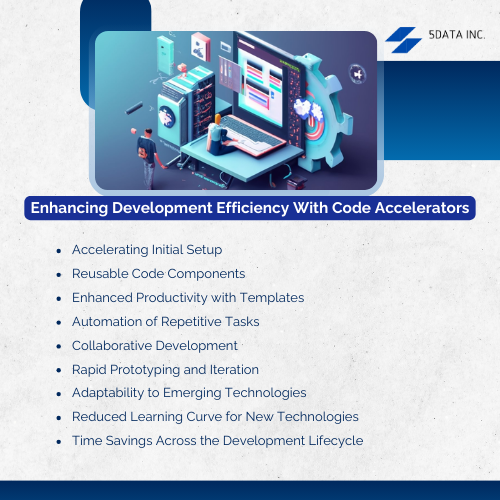In the domain of software development, time is of the essence. Whether you are crafting a small script or developing a complex application, the journey from ideation to execution is often marked by a series of intricate steps. The need for code accelerators arises from the recognition that traditional development processes can be time-consuming and prone to inefficiencies. Imagine a scenario where you could seamlessly integrate pre-built, performance-optimized code snippets into your project, significantly helping to save time on routine tasks. These are precisely the promise of code accelerators -they serve as catalysts for streamlining development by offering readily available, reusable code components.
Code Accelerators: Enhancing Development Efficiency
Once you understand your “WHY,” you hop on research and think of “HOW.” We have got you all covered here! Here is step by step detailed explanation of how code accelerators enhance development efficiency: Accelerating Initial Setup Code accelerators simplify project setup with pre-configured structures, saving time and providing a foundation for developers to start working quickly by organizing files and configurations. Reusable Code Components Code accelerators provide a repository of reusable code, allowing developers to eliminate repetition and promote code reuse across projects by leveraging existing snippets, functions, and modules. Enhanced Productivity with Templates Developers can use these templates for the initial phase, saving time and ensuring adherence to best practices from the beginning of a project. Automation of Repetitive Tasks Code accelerators can automate mundane and repetitive tasks, such as code formatting, testing, and deployment processes. Collaborative Development Teams can work more seamlessly when using the same code accelerators, promoting consistency and making it easier for developers to understand and contribute to each other’s code. Rapid Prototyping and Iteration Developers can quickly prototype ideas and iterate on them using code accelerators that provide a foundation for common features or functionalities. Adaptable to Emerging Technologies Developers using accelerators can stay current with the latest practices and technologies without investing extensive time in research and learning curves. Reduced Learning Curve for New Technologies By examining and modifying existing code, developers can quickly grasp the essentials of a technology, accelerating the learning process. Time Savings Across the Development Lifecycle By saving time at various development stages—initial setup, code enhancements, testing, and deployment—code accelerators contribute to a streamlined process, enabling teams to meet deadlines and reliably deliver high-quality products.
Applications For Code Accelerators
Building customer portals and self-service platforms: Accelerators can provide pre-built modules for user account management, forms, workflows, and reporting, significantly reducing development time and cost.- Creating internal business applications: Streamline development of tasks like expense management, asset tracking, project management, and internal communication with pre-built forms and data management capabilities.
- Developing e-commerce applications: Accelerators can offer modules for product catalogs, shopping carts, checkout processes, and payment integration, allowing for quick deployment of online stores.
- Building content management systems (CMS): Quickly create websites and landing pages with pre-built templates, drag-and-drop editing tools, and content organization features.
Automation For Rapid Deployment And Efficiency
Automation plays a crucial role in achieving rapid deployment and efficiency gains in software development. Here’s a detailed breakdown of how Automation contributes to these objectives: Continuous Integration (CI) Automation enables continuous integration, automatically merging code changes into a shared repository, ensuring regular testing, and reducing the likelihood of integration issues for a more agile development process. Continuous Deployment (CD) Automation extends to continuous deployment, ensuring fast and consistent code deployment to production environments and eliminating manual steps to prevent errors and delays. Infrastructure as Code (IaC) IaC automates infrastructure provisioning, enabling easy replication across development, testing, and production, ensuring consistent behavior and eliminating configuration drift in deployed applications. Deployment Pipelines Automation builds deployment pipelines that automate code stages—building, testing, and deploying—streamlining the entire process and minimizing manual intervention. Environment Configuration Automated tools ensure consistent configuration of development, testing, and production environments, reducing manual setup time for developers and minimizing deployment issues due to environment inconsistencies. Rollback Mechanisms Automated deployment systems feature rollback mechanisms for quick reversion to previous versions, mitigating deployment risks and enabling teams to address unexpected issues without extended downtime promptly. Task and Workflow Automation Automation tools go beyond deployment, streamlining tasks like code formatting and documentation generation, freeing developers to focus on creative and complex aspects of their work. Version Control and Branching Automated version control tracks code changes, enabling parallel development through branching, ensuring efficient management and collaboration, and minimizing conflicts. Fast-track your projects with the best rapid application development company company at your service.Code Accelerator Implementation: Key Considerations
Implementing Code Accelerators in development necessitates meticulous consideration of diverse factors to guarantee their effectiveness and maintainability. Here are crucial considerations based on the provided information: Technology Stack and Target Architecture- Each accelerator should be designed for a specific base technology stack and target architecture. Mixing multiple stacks and architectures can lead to readability issues in directory structures and configuration files.
- Ensure that the selected technology stack is in harmony with the needs of your intended environment.
- Define the scope of each accelerator to align with different types of deployments, such as back-end APIs, front-end UIs, and business services.
- Tailor accelerators to specific deployment scenarios to avoid unnecessary complexity and ensure relevance.
- Prefer OpenRewrite-based transformations over ReplaceText-based transformations when possible. OpenRewrite understands the semantics of files, providing more accurate and robust modifications.
- Use ReplaceText with caution, considering it a last resort, especially when employing regex mode. Clearly understand and document the limitations of regex-based transformations.
- Name accelerators intuitively without including the word “accelerator” in the name.
- Use appropriate and intuitive icons to represent accelerators visually.
- Apply tags that reflect language, framework, and service type, using lowercase letters and specific characters. It enhances searchability and organization.
- Expose configuration options for accelerators, keeping them straightforward and well-documented. Use default values when appropriate and make options conditional on each other as needed.
- Keep options short and easy to navigate for users. Clearly state the role of each option in the accelerator.
- Implement regular expression-based validation for free text options with limitations to ensure early feedback on invalid user input.
- Provide meaningful descriptions for options to guide users effectively.
- Generated application skeletons must include a detailed README file describing the function and structure of the application.
- Provide information on building, deploying, and using the generated application. This documentation is crucial for developers who will be working with the accelerator.
- Ensure that accelerators generating application skeletons include a comprehensive test suite for different layers of the application.
- Develop an overall application test that verifies the functionality and startup of the application.
- Include unit tests for each layer (presentation, business, data) using stubbing or mocking frameworks.
- Implement integration tests, especially for critical layers like presentation and data, incorporating scenarios like database interactions using tools like test containers.
Let’s Accelerate Your Business
At 5DATAINC, our code accelerator lab focuses on creating secure, integrable, and scalable software accelerators. Our solutions streamline cost-efficient custom software development, serving as off-the-shelf solutions to fill functionality gaps. Deploy quickly, go to market faster—no need to start from scratch. With easy customization and uncompromised quality, our accelerators help to turbocharge your Minimum Viable Product.
About the Author...
Almaas Saleem is a skilled software engineer from Kerala, India who currently resides in East Africa. She is passionate about technology and constantly seeks to learn more about it through reading and hands-on experience. Almaas excels in web development, design, automated testing software, ethical hacking, cybersecurity, and digital marketing. She also works as a technical writer for new businesses, managing various entities. Almaas is distinguished by her steadfastness and commitment to her work, which consistently yields excellent results.
